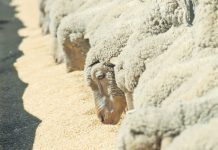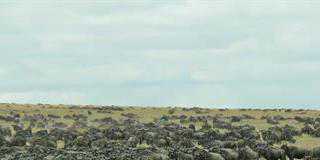
Photo: Lindi Botha
Farmer Giovanna Secco stands in silence among the sweet-smelling macadamia and papaya blossoms on her farm in Lows Creek, Mpumalanga.
“Where are the bees?” she asks.
It should be one of the busiest times of year for pollinators on the farm, but despite the fact that Secco has hired around 300 hives, at R90 000/month, the bees and their comforting buzzing are absent.
Secco has reason to be concerned. Studies show that without bees, nut set of macadamia trees would reach only 30%. The industry is therefore desperate for bees, and it’s not the only one.
The Mpumalanga Lowveld is also a hotspot for avocado, citrus and papaya production, and it is estimated that twice as many bees will be needed here within a decade to pollinate the growing orchards, all of which flower at the same time.
A recent, chilling study by Dr Hannelie Human of the University of Pretoria’s Department of Entomology and Zoology shows that 70% of South Africa’s migratory bees have been lost.
The number of beekeepers is also dwindling, and this is exacerbating the crisis. Beekeeper Michel Lenferna says there are more beekeepers exiting the industry than entering it.
“Vandalism, low honey prices, and a decline in honey production in colonies are making it harder for beekeeping to be sustainable. This will push the supply of, and demand for, pollination services to an unfavourable level for farmers, and there’s a real risk that there won’t be any bees in the future,” he says.
Lenferna has suffered multiple losses due to the vandalism and theft of hives over the last three years; in 2020 alone, his losses amounted to R350 000.
Lacking ethics
While Secco has taken steps to ensure that her crops are pollinated, the absence of bees points to another problem: unethical beekeeping services. She says this is aggravating the problem of dwindling bee populations.
“The beekeepers blame farmers for spraying chemicals and killing the bees, but this isn’t always the case. The bees brought in to pollinate are so weak to begin with that they can hardly do the job,” she explains.
Weak colonies and the disappearance of migratory bees raised the alarm for Secco, who set about investigating the issue on her farm and further afield. She uncovered what she calls “an unsavoury industry”.
“We’ve struggled for years to get decent bees on the farm and have dealt with all kinds of beekeepers. One said that if we bought all the hives, he would run the pollination for us. It worked for a while and then he suddenly left, and there we sat with all the hives and no one to manage the bees.
“Another just didn’t bother to care for the bees properly. The hives would be placed in full sun, and the bees inevitably spent their days cooling the queen instead of foraging and pollinating.”
Secco has done her fair share to provide an adequate habitat for bees on her farm. She has erected structures to prevent badgers from stealing the honey from the hives, and has scattered blue basil about the farm, a rich source of forage for bees that helps to ensure a healthy, diverse diet and prevent wild colonies from absconding.
Yet another beekeeper she hired couldn’t resist the benefits of the basil, and was found placing catch boxes near the plants. “While we were doing everything to keep the bees on our farm, this beekeeper was collecting the bees and taking them to the next farm to use for pollination services,” she explains.
When the deafening silence on Secco’s farm became unbearable, she donned a beekeeping outfit one night to see for herself what was going on in her hives. What she found was near-empty hives, and some that didn’t have any bees at all.
“And this is what we were paying R90 000/month for!” she exclaims.
So how do farmers who aren’t trained in beekeeping know if they are getting their money’s worth? While Secco says that opening up the boxes at night is a sure way to tell if the hives are being populated optimally, this is something very few farmers do. And even if they did, it is unlikely that many farmers would be able to identify a healthy hive.
Optimal performance
Lenferna says that, first off, a colony needs to be ‘queenright’, which means that a laying queen must be present in the box.
Inge Lotter, beekeeper and chairperson of the Mpumalanga Beekeepers’ Association, explains that productive hives are those that have the maximum amount of hungry mouths waiting for pollen.
“This means lots of baby bees that need food, which will require adult bees to go out and forage, pollinating along the way,” she says.
Farmers have the right to ask beekeepers for an opportunity to see inside the hives, and must look out for at least six frames covered with bees, of which three or four should be brood.
In trying to determine whether hives are active enough to provide pollination services, many farmers count the number of bees coming and going from the hives. However, Lenferna points out that bee activity differs throughout the day, so opening up the hives to count the frames and brood provides a more accurate picture.
He adds that one colony of 30 000 bees is better than two colonies of 15 000 bees each. “A stronger colony will do more work than a weaker one, because only bees that are surplus to the requirement of the hive can go out and forage. Bees will only fetch pollen when there’s a brood to feed.”
Worked to death
In her quest for answers regarding the low bee numbers, Secco came across beekeeping practices she describes as “tantamount to prostitution”. “The bees are being completely overworked, which is why they are weak and dying.”
She explains that unethical beekeepers cart bees from one farm to the next to capitalise on the peak flowering season in the Lowveld. Then, instead of feeding the bees during the off season, they sell them to sunflower farmers on the Highveld. When the Lowveld is in bloom again, the beekeepers collect bees from surrounding forestry plantations, and the cycle begins again.
Mike Allsopp, head of honeybee research at the Agricultural Research Council’s Plant Protection Research Institute, clarifies that when bees have good forage, it would be inaccurate to consider them ‘overworked’, as the quality of food sustains and encourages them to work harder, reproduce and thrive.
“But without quality forage, bees are forced to work harder for their food. This, and being moved around constantly, places strain on the bees and weakens them,” he says.
He adds that commercial pollination settings are not advantageous to bees in general, as very high densities of bees are required to deliver maximum fruit, nut or seed yield.
“In many cases, there isn’t enough food or enough varied food to sustain the colonies for any length of time. Pollination services are not very beneficial to bees, as they’re forced to work in high-exposure, low-reward commercial pollination settings, which results in overworked bees. If colonies are overstressed, they’ll abscond due to the lack of food, or they’ll starve.”
According to Lotter, a bee’s lifespan is associated with the number of times the insect beats its wings. “The duration of a bee’s life is determined by how hard it works; the further it has to fly to find food, the shorter its life will be.”
Allsopp says it is good management to move the colonies to a more bee-friendly environment so they can recover before getting too weak.
“However, this is often difficult to do perfectly when managing thousands of colonies, and with highly variable seasons, some losses during pollination season are expected.”
Secco questions the viability of catching bees in the wild and using them for pollination services. “This isn’t sustainable, especially when these bees are moved from Lowveld plantations to Highveld sunflower farms where they are decimated by the agricultural chemicals they’re exposed to.”
Allsopp says it is also uncertain whether bees should be harvested in one region of the country, and then moved to another.
“In reality, we don’t know enough about South Africa’s natural bee population to make any determination in this regard. There are certainly no data that show the practice has diminished the wild honeybee population, or that the movement has caused any disease or genetic problems.
“Logic suggests there’s some degree of local adaptation in the population that makes it inadvisable to move bees long distances, and there must be some limit to how many colonies you can harvest from the wild. But at present, there are no data to indicate that these are unethical practices. There’s a great need for baseline research to answer some of these questions.”
Secco believes that while supporting bees is important, so is supporting ethical beekeepers.
“We need to create an environment that sustains both bees and beekeepers. Bees are our biggest investment. You can have the best trees, the best soils, and perfect weather, but if you don’t have bees, you don’t have anything,” she concludes.
Email Giovanna Secco at [email protected], Dr Hannelie Human at [email protected], or Mike Allsopp at [email protected].













